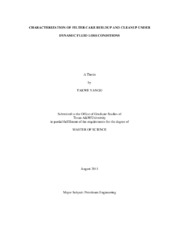| dc.description.abstract | Hydraulic fracturing is a popular stimulation method in tight gas and shale gas reservoirs that uses a viscous fluid to fracture the reservoir rock and uniformly transport proppant to create a highly conductive path that is kept open by the proppant after fracturing. This method is used to improve the productivity of the otherwise low permeability reservoirs. Hydraulic fracturing, though in general beneficial, is a complex process that has a number of challenges in fracturing design and execution. This research focuses on studying the damage caused by the fracturing fluid (gel) to the fracture and the conditions to remove the damage. Guar gum and its derivatives have been the most commonly used polymers to increase the viscosity of fracturing fluids. The fracturing fluid gets dehydrated under pressure leaving behind a highly concentrated unbroken residue called filter cake which causes permeability impairment in the proppant pack, resulting in low fracture conductivity and decreased effective fracture length.
This study seeks to characterize filter cakes. By measuring its thickness and with the leak off volume, the concentration and yield stress of the filter cake can be estimated. The thickness of the filter cake was measured with a precise laser profilometer.
Correlations are proposed to estimate filter cake properties (thickness, concentration and yield stress) based on pumping conditions (pump rate, time and net pressure) and rock properties. With these properties known, a required flow back rate of the reservoir fluid can be estimated to clean up the filter cake modeled as a non-newtonian fluid exhibiting a yield stress.
Typical field conditions were referenced and scaled down in the lab to closely represent the field conditions. Recommendations are provided on gel damage based on the observation of the study. | en |


